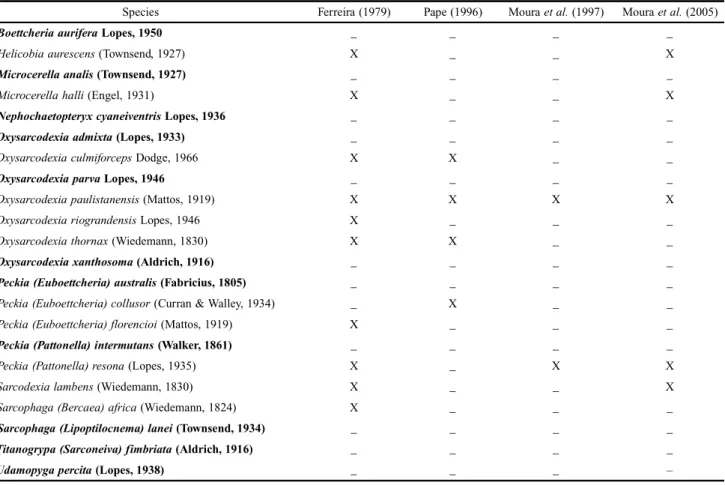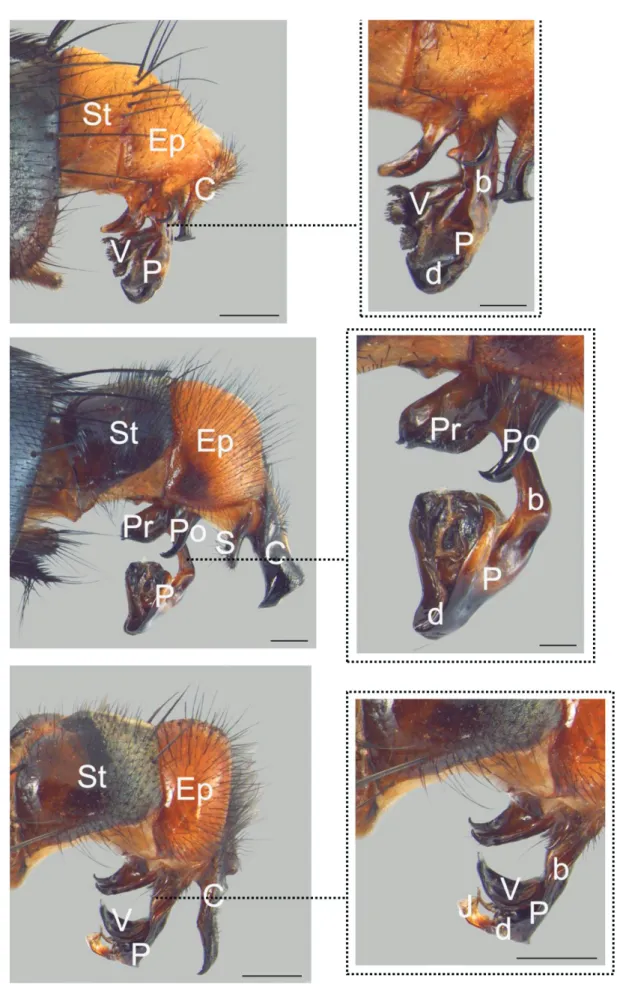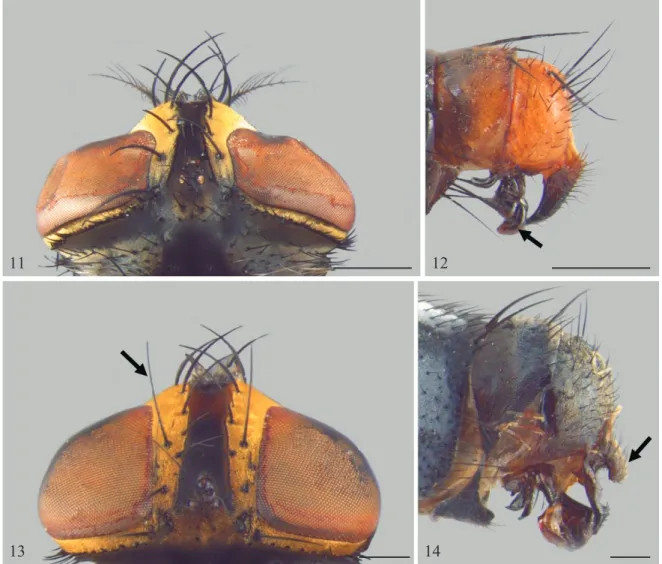The widely distributed Sarcophagidae includes approxi-mately 2510 extant species, most from warm climates. Three subfamilies have been recognized: Miltogramminae, Paramacronychiinae and Sarcophaginae. The latter is the most diverse, and includes species that are important to forensics (Pape 1996).
Sarcophaginae larvae feed on excrements and decompos-ing organic matter (Byrd & Castner 2001), includdecompos-ing carcasses and corpses. Additionally, some species are me-chanical vectors of pathogens or are known to cause myiasis in vertebrates (Zumpt 1965).
Despite their importance, species in Sarcophaginae are difficult to separate based on external characters, and can only be successfully identified after careful analysis of the male genitalia (de Carvalho & Mello-Patiu 2008). Their ex-ternal morphology is either too uniform or vary too much, being generally useless for identification purposes.
Sarcophagidae have been found on animal carcasses throughout the decomposition process, being slightly less ubiquitous only during the advanced stages of decomposi-tion (Barros et al. 2008).
Experiments using animal carcasses have proved impor-tant to forensics because they provide data on the local insect fauna relevant to the decomposition process (Barbosa et al. 2010). Undeniably, forensic entomology can only be applied in areas where the composition and biology of the insect fauna at different stages of carrion decomposition are already known.
Medicolegal forensic entomology is able to provide rel-evant and important data during a criminal investigation, such
as whether a corpse has been moved or not (Anderson 2005), or whether the victim was a drug user or had been poisoned (Introna et al. 2001). It can also reveal instances of negli-gence towards incapacitated people or animals (Benecke & Lessing 2001; Benecke et al. 2004; Anderson & Huitson 2004). Most importantly, however, forensic entomology can help determine the amount of time a victim has been ex-posed to the environment, facilitating the estimate of the post-mortem interval (PMI) (Oliveira-Costa & Mello-Patiu 2004; Pujol-Luz et al. 2006).
This work presents an identification key to the species of Sarcophagidae found in the municipality of Curitiba, state of Paraná, southern Brazil. In order to facilitate the use of the key by criminal investigators and researchers in general who are not taxonomists, the main features of the male terminalia are illustrated through photographs.
MATERIAL AND METHODS
Specimens were collected in a “capão” with approxi-mately five acres, located in Curitiba-PR (25°25’S and 49°14’W) at the campus of the Centro Politécnico, Universidade Federal do Paraná. The area is a remnant of mixed ombrophilous forest with three well-defined strata, moderately humid soil, and low elevations. The soil has a high percentage of clay, hindering the absorption of water from the rain. It is also acidic due to the large amount of ferns and poor in boron, due to the presence of Baccharis trimera (“carqueja”), characterizing the vegetation as pio-neer (Mise et al. 2007).
KEYWORDS.Flesh flies; medico-legal entomology; morphology, taxonomy.
RESUMO. Chave pictórica para a identificação das espécies de Sarcophagidae (Diptera) de potencial importância forense do sul do Brasil.Espécies da subfamília Sarcophaginae são importantes para a entomologia forense devido ao seu hábito necrófago. Este trabalho apresenta uma chave pictórica para a identificação de 22 espécies de Sarcophaginae de 10 gêneros encontradas na região sul do Brasil. São fornecidas fotografias dos principais estruturas das espécies, principalmente da terminália masculina.
& Wood (2009) for the external and genital morphologies, and Silva & Mello-Patiu (2010) for some phallic structures characteristic of Sarcophagidae. The general classification and geographic distribution of species follow Pape (1996). Photographs were taken with a Leica DFC 500 digital cam-era and an Auto-Montage Pro Digital Imaging System (Syncropy), using a Leica MZ16 stereomicroscope.
The experiment was authorized by the “Comitê de Ética em Experimentação Animal (CEEA)”, biological sciences branch, Universidade Federal do Paraná, process number 23075.083831/2009–87.
1. Arista with short plumosity restricted to the basal half of the arista length (Fig. 2) ... 2 1’. Arista with long plumosity reaching beyond the basal half of the arista length (Fig. 3) ... 3 2. Head mostly silver microtomentose (Fig. 4); epandrium yellowish brown, syntergosternite 7+8 dark brown, subshiny, cerci brown with dark apex and scarce pillosity (Fig. 5). Neotropical – Argentina, Bolivia, Brazil (Ceará, Minas Gerais, Paraná, Rio Grande do Sul, São Paulo) ...
... Microcerella halli (Engel)
Table I. Species of Sarcophaginae (Diptera, Sarcophagidae) collected from a domestic pig carrion in Curitiba, Paraná, Brazil, from July, 2009 to October, 2009, compared with other records for the state of Paraná (boldface = new records).
Species Ferreira (1979) Pape (1996) Moura et al. (1997) Moura et al. (2005)
Boettcheriaaurifera Lopes, 1950 _ _ _ _
Helicobiaaurescens (Townsend, 1927) X _ _ X
Microcerellaanalis (Townsend, 1927) _ _ _ _
Microcerellahalli (Engel, 1931) X _ _ X
Nephochaetopteryxcyaneiventris Lopes, 1936 _ _ _ _
Oxysarcodexiaadmixta (Lopes, 1933) _ _ _ _
Oxysarcodexiaculmiforceps Dodge, 1966 X X _ _
Oxysarcodexiaparva Lopes, 1946 _ _ _ _
Oxysarcodexiapaulistanensis (Mattos, 1919) X X X X
Oxysarcodexiariograndensis Lopes, 1946 X _ _ _
Oxysarcodexiathornax (Wiedemann, 1830) X X _ _
Oxysarcodexiaxanthosoma (Aldrich, 1916) _ _ _ _
Peckia (Euboettcheria) australis (Fabricius, 1805) _ _ _ _ Peckia (Euboettcheria) collusor (Curran & Walley, 1934) _ X _ _
Peckia (Euboettcheria) florencioi (Mattos, 1919) X _ _ _
Peckia (Pattonella) intermutans (Walker, 1861) _ _ _ _
Peckia (Pattonella) resona (Lopes, 1935) X _ X X
Sarcodexialambens (Wiedemann, 1830) X _ _ X
Sarcophaga (Bercaea) africa (Wiedemann, 1824) X _ _ _
Sarcophaga (Lipoptilocnema) lanei (Townsend, 1934) _ _ _ _
Titanogrypa (Sarconeiva) fimbriata (Aldrich, 1916) _ _ _ _
Fig. 1.Genital structures of Oxysarcodexia, Peckia and Sarcophaga, respectively. Abbreviations: b- basiphallus; d: distiphallus; C: cercus; Ep: epandrium;
2’. Head mostly black with few microtomentose areas (Fig. 6); epandrium yellowish, syntergosternite 7+8 shiny black, cerci black with pillosity dense and long (Fig. 7). Neotro-pical – Brazil (Espiríto Santo, Minas Gerais, Paraná, Rio de Janeiro, Santa Catarina, São Paulo) ...
...Microcerella analis (Townsend) 3. Vein R1 setose dorsally (Fig. 8) ... 4 3’. Vein R1 bare dorsally ... 6 4. Body more than 10 mm long; phallus with apex membra-nous and conspicuously spiny (Fig. 9), surstylus with apex slender and covered with spines (Fig. 10). Neotropical – Argentina (Salta), Brazil (Bahia, Paraná, Rio de Janeiro,
Santa Catarina), Dominica, Dominican Republic, Jamaica, Mexico (Jalisco), Peru ...
...Titanogrypa (Sarconeiva) fimbriata (Aldrich) 4’. Body less than 10 mm long; phallus with apex sclerotized and without spines, apex of surstylus without spines ...
... 5 5. Proclinate fronto-orbital setae absent (Fig. 11); terminalia reddish-brown, cercus dorsally straight and without api-cal spines, distiphallus round and reniform (Fig. 12). Neo-tropical – Argentina (Catamarca, Corrientes, Misiones), Brazil (Paraná, Rio de Janeiro, São Paulo) ...
...Helicobia aurescens (Townsend)
Figs. 2–3.Head, lateral view.1, Microcerella halli; 2, Peckia (Euboettcheria) australis. Scale: 0.5 mm.
Figs. 4–5.Head and male terminalia of Microcerella halli, lateral view. Scale: 0.5 mm.
2 3
Figs. 6–10. 6–7,Head and male terminalia of Microcerellaanalis, lateral view. 8,Wing of Helicobia aurescens, dorsal view. 9–10, Terminalia of Titanogrypa (Sarconeiva) fimbriata, lateral view. Scale: 0.5 mm.
6 7
8
9 10
5’. Proclinate fronto-orbital setae present, two (Fig. 13); terminalia dark-brown, cercus dorsally folded posteriorly, bearing apical spines, distiphallus enlarged and not reni-form (Fig. 14). Neotropical – Brazil (Paraná, São Paulo) ...Nephochaetopteryx cyaneiventris Lopes 6. Mid femur with posteroventral ctenidium (Fig. 15) ... 7 6’. Mid femur without posteroventral ctenidium ... 13 7. Cercus cuneiform; syntergosternite 7+8 and tergite 5 uni-formly colored, vesica of phallus variously shaped ... 8 7’. Cercus not cuneiform; syntergosternite 7+8 with a dorsal spot of intense golden microtomentum, and tergite 5 with a lateral one (Figs 16, 17); vesica of phallus with a trans-lucent membrane. Neotropical – Argentina, Brazil (Minas Gerais, Paraná, Rio de Janeiro, Rio Grande do Sul, Santa Catarina, São Paulo), Paraguay ...
...Oxysarcodexia culmiforceps Dodge 8. Vesica concave with two lateral lobes bearing spines, apex of distiphallus three times wider than basiphallus (Figs. 18, 19). Argentina (Misiones), Brazil (Goiás, Mato Grosso,
Figs. 11–14. 11–12,Head (dorsal view) and terminalia (lateral view) of Helicobia aurescens. 13–14,Head (dorsal view) and terminalia (lateral view) of
Nephochaetopteryx cyaniventris. Scale: 0.5 mm.
Fig. 15.Mid femur of Oxysarcodexia admixta, posterior view. Scale: 0.5 mm.
Minas Gerais, Paraná, Rio de Janeiro, Santa Catarina, São Paulo) ...Oxysarcodexia admixta (Lopes)
11 12
8’. Vesica very well developed and not shaped as above... 9 9. Vesica in lateral view with two lobes bearing apical spines, anterior margin of distiphallus serrated, with the upper-most projection longer than the others (Figs. 20, 21). Neotropical – Argentina (Jujuy), Brazil (Paraná, Rio de Janeiro, Rio Grande do Sul, São Paulo) ... ...Oxysarcodexia riograndensis Lopes 9’. Vesica and anterior margin of distiphallus not as above...10 10. Phallus with digitiform projection on the posterior por-tion of distiphallus, vesica with a large laminar porpor-tion and with margin serrated (Figs. 22, 23). Neotropical – Ar-gentina (Catamarca, Jujuy, Misiones), Bolivia, Brazil
(Amazonas, Ceará, Espírito Santo, Goiás, Mato Grosso, Minas Gerais, Pará, Paraíba, Paraná, Pernambuco, Rio de Janeiro, Rio Grande do Sul, Santa Catarina, São Paulo), Ecuador, Guyana, Paraguay, Peru) ...
...Oxysarcodexia thornax (Wiedemann) 10’. Phallus without digitiform projection on the posterior portion of distiphallus, vesica variously shaped ... 11 11. Cercus in lateral view with apex abruptly expanded, vesica with apical round lobes (Figs. 24, 25). Neotropical – Ar-gentina (Jujuy, Misiones), Brazil (Ceará, Mato Grosso, Minas Gerais, Paraná, Rio de Janeiro, São Paulo) ...
...Oxysarcodexia parva Lopes
Figs. 16–19. 16–17,Terminalia and adult male of Oxysarcodexia culmiforceps, lateral view. 18–19,Terminalia of Oxysarcodexia admixta, lateral view.
Scale: 0.5 mm.
18 19
11’. Cercus without apex abruptly expanded, vesica with ter-minal lobes variously shaped ... 12 12. Vesica in lateral view with three lobes bearing apical spines (Figs. 26, 27). Neotropical – Argentina (Buenos Aires, Córdoba, Entre Ríos), Brazil (Minas Gerais, Paraná, Rio de Janeiro, Rio Grande do Sul, São Paulo), Chile (San-tiago) ...Oxysarcodexia paulistanensis (Mattos) 12’. Vesica in lateral view with two lobes, upper lobe shaped
as a long spiny ribbon (Figs. 28, 29). Neotropical – Ar-gentina (Misiones), Brazil (Amazonas, Ceará, Espirito Santo, Mato Grosso, Minas Gerais, Pará, Paraná, Rio de Janeiro, São Paulo), Colombia, Costa Rica, Ecuador, El Salvador, Guatemala, Guyana, Mexico (Jalisco, Veracruz), Panama, Peru ...Oxysarcodexia xanthosoma (Aldrich) 13. Mid tibia with long median anterior seta that extends beyond apex of tibia (Fig. 30); apex of cercus truncated,
Figs. 20–23. 20–21,Terminalia of Oxysarcodexia riograndensis, lateral view. 22–23,Terminalia of Oxysarcodexia thornax, lateral view. Scale: 0.5 mm.
20 21
phallus small and bifid in frontal view (Fig. 31). Neotro-pical – Argentina (Misiones, Tucumán), Bahamas (Grand Bahamas, New Providence), Bolivia, Brazil (Ceará, Mato Grosso, Paraná, Rio de Janeiro, Santa Catarina, São Paulo), Chile (Tarapacá), Colombia, Costa Rica, Cuba, El Salva-dor, Guyana, Haiti, Jamaica, Mexico (Jalisco, Nuevo León, Tamaulipas), Panama, Paraguay, Peru, Puerto Rico, St. Vincent, Trinidad & Tobago (Tobago) ...
...Sarcodexia lambens (Wiedemann) 13’. Mid tibia without long, median anterior seta extending beyond apex of tibia; apex of cercus generally slender, phallus variable in shape... 14 14. R4+5 with dorsal setae (Fig. 32); hind trochanter with an anteroventral spine-pad ... 15 14’. R4+5 without dorsal setae; hind trochanter without a spine-pad ... 16
Figs. 24–27. 24–25,Terminalia of Oxysarcodexia parva, lateral view. 26–27,Terminalia of Oxysarcodexia paulistanensis, lateral view. Scale: 0.5 mm.
24 25
Figs. 28–31. 28–29,Terminalia of Oxysarcodexia xanthosoma, lateral view. 30–31,Mid tibia (posterior view) and terminália (lateral view) of Sarcodexia lambens. Scale: 0.5 mm.
28 29
Figs. 32.Wing of Udamopyga percita, dorsal view. Scale: 0.5 mm.
15. Cercus with a basal tuft of setae, vesica small and sim-ple; postalar wall setose, sternite 5 without posteriorly oriented projection (Fig. 33). Neotropical – Brazil (Paraná, Rio de Janeiro, São Paulo)..Udamopyga percita (Lopes) 15’. Cercus with setae uniformly distributed (Fig. 34), vesica well developed and conspicuously projected anteriorly; postalar wall naked, sternite 5 with posteriorly oriented projection. Neotropical – Brazil (Paraná, Santa Catarina, São Paulo) ...Boettcheria aurifera Lopes 16. Cercus with upper portion folded posteriorly forming a conspicuously setose projection, apex of distiphallus with posterior rounded and spiny lobe (juxta) (Figs. 35, 36). Neotropical – Argentina (Salta), Brazil (Paraná, Rio
Grande do Sul, Santa Catarina, São Paulo) ... ...Sarcophaga (Lipoptilocnema) lanei (Townsend) 16’. Cercus without upper projection, apex of distiphallus without a spiny juxta as described above ... 17 17. Phallus with conspicuous juxta and distinctly separated from distiphallus, oriented anteriorly, vesica slightly con-cave (Fig. 37), gena silver microtomentose (Fig. 38). Neotropical – Argentina (Buenos Aires), Brazil (Paraná, Rio de Janeiro, Rio Grande do Sul), Costa Rica, Cuba, Mexico, Paraguay ...
...Sarcophaga (Bercaea) africa (Wiedemann) 17’. Phallus with juxta never distinctly separated from distiphallus, vesica variable, yellow microtomentose ... 18
Figs. 33–34.Terminalia of Udamopyga percita and Boettcheria aurifera, lateral view. Scale: 0.5 mm.
Figs. 35–38. 35–36,Terminalia of Sarcophaga (Lipoptilocnema) lanei, lateral view. 37–38,Terminalia and head of Sarcophaga (Bercaea) africa, lateral view. Scale: 0.5 mm.
18. Marginal scutellar setae three (including apical seta) (Fig. 39); pregonite enlarged (Fig. 41); distiphallus with apex distinctly enlarged ... 19 18’. Marginal scutellar setae four (including apical seta) (Fig. 40); pregonite slender (Fig. 42); distiphallus without dis-tinctly enlarged apex ... 20 19. Surstylus slender; apex of cercus with anterior pointed projection; distiphallus anteriorly flattened and enlarged (Fig. 43). Neotropical – Argentina (Corrientes), Brazil (Paraná, Rio de Janeiro, Rio Grande do Sul, Santa Catarina, São Paulo) ...Peckia (Pattonella) resona (Lopes)
19’. Surstylus round; apex of cercus with anterior round pro-jection; distiphallus shaped as a cotyledon (Fig. 44). Neotropical – Brazil (Ceará, Goiás, Mato Grosso, Pará, Paraná, Rio de Janeiro, Santa Catarina, São Paulo), Costa Rica, Ecuador, Guatemala, Guyana, Honduras, Mexico (Jalisco), Panama, Paraguay, Peru, St. Lucia, Trinidad & Tobago (Tobago, Trinidad) ...
...Peckia (Pattonella) intermutans (Walker) 20. Cercus with a tuft of pre-apical setae, expanded dorsally and intensely microtomentose; phallus short (Fig. 45). Neotropical – Argentina, Bolivia, Brazil (Bahia, Ceará,
35 36
Mato Grosso, Paraná, Rio de Janeiro, Santa Catarina), Costa Rica, Guyana, Panama, Trinidad & Tobago (Trini-dad) .... Peckia (Euboettcheria) collusor (Curran & Walley) 20’. Cercus without a tuft of pre-apical setae, not intensely microtomentose; phallus short or long ... 21 21. Cercus with strong spines on the anterior apical half, with setae concentrated on the posterior portion, phallus short and slightly enlarged (Fig. 46). Neotropical – Argentina (Misiones, São Luis), Brazil (Mato Grosso, Paraná, Rio Grande do Sul, Santa Catarina, São Paulo) ... ...Peckia (Euboettcheria) florencioi (Mattos)
21’. Cercus without spines, with setae sparsely distributed along its axis, phallus slender and very long (Fig. 47). Neotropical – Argentina (Misiones), Brazil (Mato Grosso, Paraná, Rio Grande do Sul, Santa Catarina, São Paulo), Paraguay ...Peckia (Euboettcheria) australis (Fabricius)
DISCUSSION
This contribution provides a quick and efficient tool to identify the species that visit pig carcasses in the region of Curitiba, Paraná. Given the species’ distributions, our key
Figs. 39–42. 39–40,Scutellum of Peckia (Pattonella) intermutans and Peckia (Euboettcheria) australis, dorsal view. 41–42,Terminalia (pregonite) of
Peckia (Pattonella) resona and Peckia (Euboettcheria) florencioi, lateral view. Scale: 0.5 mm.
41 42
may be extrapolated to other areas in the southern and south-eastern Brazil.
Titanogrypa (Sarconeiva) fimbriata and Udamopyga percita are mollusk parasitoids (Lopes 1940) and their pres-ence in our samples are most likely accidental, as each species was collected only once by us. However, they had not been previously recorded in the region. Even though taxonomical studies are important to the biological sciences in general, they are particularly relevant to forensics, because errone-ous species identifications can mislead expert reports. For this reason, basic taxonomic research is essential to the progress of this science in the country.
ACKNOWLEDGEMENTS
We thank TaxonLine – Rede Paranaense de Coleções Biológicas- for the photographs in this work; Conselho
Nacional de Desenvolvimento Científico e Tecnológico (CNPq) for a MS (KPV) and a postdoctoral (CAMP) schol-arships, and a research grant (CJBC – process number 300873/2008–5).
REFERENCES
Anderson, G. S. 2005. Forensic Entomology, p. 135–164. In: S. H. James;
J. J. Nordby (eds.). Forensic Science – An Introduction to Scientific and Investigative Techniques. xxxi + 778 p.
Anderson, G. S & N. R. Huitson. 2004. Myiasis in pet animals in British Columbia: The potential of forensic entomology for determining duration of possible neglect. Canadian Veterinary Journal 45: 993–998. Barbosa, R. R.; C. A. Mello-Patiu, A. Ururahy-Rodrigues; C. G. Barbosa
& M. M. C. Queiroz. 2010. Temporal distribution of ten calyptrate dipteran species of medicolegal importance in Rio de Janeiro, Brazil.
Memórias do Instituto Oswaldo Cruz 105:191–198.
Barros, R. M; C. A. Mello-Patiu & J. R. Pujol-Luz. 2008. Sarcophagidae (Insecta: Diptera) associados à decomposição de carcaças de Sus scrofa
Figs. 43–47. 43–44, Terminalia of Peckia (Pattonella) resona and Peckia (Pattonella) intermutans, lateral view. 45–47,Terminalia of Peckia (Euboettcheria) collusor, Peckia (Euboettcheria) florencioi and Peckia (Euboettcheria) australis, lateral view. Scale: 0.5 mm.
43 44
II: Sarcophagidae. Revista Brasileira de Biologia 39: 773–781. Introna, F.; C. P. Campobasso & M. L. Goff. 2001. Entomotoxicology.
Forensic Science International 120: 42–47.
Lopes, H. S. 1940. Contribuição ao conhecimento do gênero Udamopyga
Hall e de outros Sarcophagideos que vivem em moluscos no Brasil (Diptera). Revista de Entomologia 11:925–955.
Lopes, H. S. 1973. Collecting and rearing Sarcophagid flies (Diptera) in Brazil during forty years. Anaisda Academia Brasileira de Ciências 45: 279–291.
Received 20/1/2011; accepted 16/6/2011 Editor: Marcia Souto Couri
Pujol-Luz, J. R.; H. Marques; A. U. Rodrigues; J. A. Rafael; F. H. A. Santana; L. Chaves & R. Constantino. 2006. A Forensic Entomology Case from the Amazon Rain Forest. Journal of Forensic Science 51: 1–3. Silva, K. P & C. A. Mello-Patiu. 2010. New species of Dexosarcophaga
Townsend from Panama with an illustrated key to species of the subgenus Bezzisca (Diptera: Sarcophagidae). Journal of Natural History44: 89–106.


